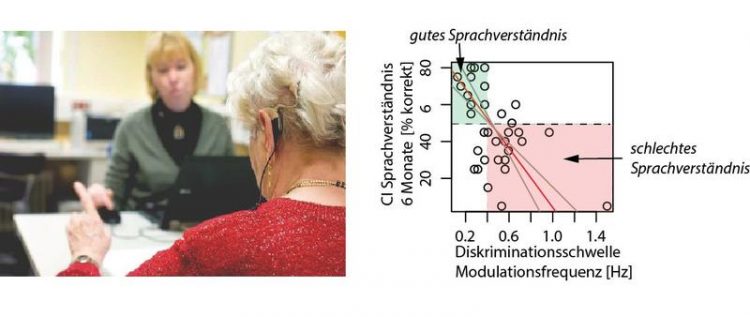Speech comprehension with a cochlear implant

Speech comprehension with a cochlear implant IPSY / Universität zu Lübeck
Currently the only neuroprostheses that can successfully replace a sensory organ are cochlear implants: They can restore hearing in deaf patients. Cochlear implants pick up sound and translate it into an electric signal which is transmitted directly to the auditory nerve, thus by-passing the damaged middle or inner ear.
The transduced sound signal is considerably distorted, however, sounding like a “harsh whisper”, as some patients would describe it. Cochlear implant recipients vary largely in how well they adapt to their device: Some learn to comprehend speech even under difficult listening condi¬tions, such as on the phone or in a pub, while others hardly benefit from their device. The source of this variability is still elusive.
Previous studies have shown that clinical factors such as duration of deafness clearly influence speech recognition with a cochlear implant. A recent study demonstrates that non-speech temporal auditory abilities also contribute considerably to speech outcome (doi: 10.1097/AUD.0000000000000588).
Researchers at the Max Planck Institute for Human Cognitive and Brain Sciences, the Cochlear Implant Center Leipzig, and the University of Lübeck tested newly implanted adults on their capacity to hear temporal modulations in noise. This novel hearing test turned out to be highly correlated with future speech recognition: Patients, who could better hear temporal modulations were also the ones, who had a better speech comprehension six months later. In contrast, the ones with poor auditory temporal resolution had an increased risk of poor future speech comprehension.
For the growing number of cochlear implant patients (to date approximately 150 000 in Europe), this adaptation process is a vital necessity. After a period of deafness, adjusting to the extremely degraded, unfamiliar signal delivered by the implant enables the listener to extract meaning from a messy auditory signal. Novel, reliable hearing tests are essential with respect to two points: On the one hand, they allow to identify poor performers early on and to consequently prescribe appropriate training measures. On the other hand, they can help to improve CI algorithms on an individual basis.
Erb J, Ludwig AA, Kunke D, Fuchs M, & Obleser J. Temporal sensitivity measured shortly after cochlear implantation predicts six-month speech recognition outcome (Ear Hear. 2018 Apr 24. doi: 10.1097/AUD.0000000000000588. [Epub ahead of print]).
Media Contact
More Information:
http://www.uni-luebeck.deAll latest news from the category: Medical Engineering
The development of medical equipment, products and technical procedures is characterized by high research and development costs in a variety of fields related to the study of human medicine.
innovations-report provides informative and stimulating reports and articles on topics ranging from imaging processes, cell and tissue techniques, optical techniques, implants, orthopedic aids, clinical and medical office equipment, dialysis systems and x-ray/radiation monitoring devices to endoscopy, ultrasound, surgical techniques, and dental materials.
Newest articles

NASA: Mystery of life’s handedness deepens
The mystery of why life uses molecules with specific orientations has deepened with a NASA-funded discovery that RNA — a key molecule thought to have potentially held the instructions for…

What are the effects of historic lithium mining on water quality?
Study reveals low levels of common contaminants but high levels of other elements in waters associated with an abandoned lithium mine. Lithium ore and mining waste from a historic lithium…

Quantum-inspired design boosts efficiency of heat-to-electricity conversion
Rice engineers take unconventional route to improving thermophotovoltaic systems. Researchers at Rice University have found a new way to improve a key element of thermophotovoltaic (TPV) systems, which convert heat…



